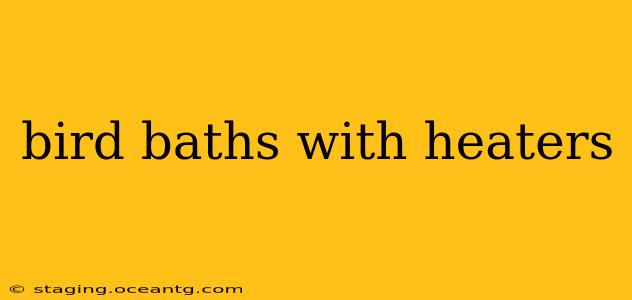Winter can be a harsh time for birds. Finding sources of unfrozen water is crucial for their survival, making heated bird baths a vital piece of winter bird care. This comprehensive guide will explore the benefits, types, and considerations for choosing and using a heated bird bath to provide a life-saving resource for your local avian population.
Why Use a Heated Bird Bath?
Simply put, heated bird baths provide a reliable source of liquid water throughout the winter months when freezing temperatures would otherwise render natural water sources unusable. Dehydration is a significant threat to birds in winter, and a heated bird bath can be the difference between life and death. Beyond hydration, a consistent water source encourages birds to visit your yard, increasing biodiversity and offering hours of enjoyable birdwatching.
Types of Heated Bird Baths
Several types of heated bird baths cater to different needs and budgets:
Electric Heated Bird Baths
These baths utilize an electric heating element to keep the water above freezing. They often feature a thermostat for temperature control and are generally easy to install and use. However, they require a power source, limiting placement options.
Solar-Powered Heated Bird Baths
These are a more eco-friendly option, using solar energy to heat the water. While convenient and sustainable, their effectiveness depends entirely on sunlight availability. Cloudy days or short winter days may render them ineffective.
Propane Heated Bird Baths
These less common models use propane to heat the water, offering consistent warmth regardless of weather conditions. They're typically more expensive and require careful handling of the propane tank.
What to Consider When Choosing a Heated Bird Bath
Choosing the right heated bird bath involves careful consideration of several factors:
Size and Capacity
Consider the number of birds you anticipate using the bath. Larger baths accommodate more birds simultaneously and are less likely to freeze over completely if the heating element malfunctions temporarily.
Heating Element Reliability
Look for bird baths with durable, well-protected heating elements. Check reviews to assess the reliability and longevity of the heating element. A malfunctioning heater renders the bath useless in winter.
Ease of Cleaning
Regular cleaning is crucial to prevent the spread of disease among birds. Choose a bird bath that’s easy to clean and maintain.
Material
Durable, weather-resistant materials such as plastic or metal are ideal for outdoor use. Ensure the material is non-toxic to birds.
Safety Features
Consider safety features such as automatic shut-offs in case of overheating or low water levels.
How to Install and Maintain a Heated Bird Bath
Installing a heated bird bath is typically straightforward, following the manufacturer's instructions. Maintenance includes:
- Regular Cleaning: Clean the bird bath regularly with a mild soap solution and water, rinsing thoroughly.
- Water Level Monitoring: Maintain a consistent water level, especially during periods of high use or cold temperatures.
- Power Cord Protection (Electric Baths): Protect the power cord from damage, particularly from snow and ice.
- Winterization (Electric/Solar Baths): Store indoor for winter if not weatherproof. Consider a draining valve to make this easier.
Frequently Asked Questions (FAQ)
How much does a heated bird bath cost?
Prices vary widely depending on the type, size, and features. Expect to pay anywhere from a few tens of dollars to several hundred.
Do I need to add antifreeze to a heated bird bath?
No, adding antifreeze is extremely harmful to birds. The heating element is designed to prevent freezing, so antifreeze is entirely unnecessary and potentially lethal.
Can I use a regular bird bath with a heating pad?
While possible, this setup is often less efficient and may not provide consistent warming. Dedicated heated bird baths offer better temperature control and protection from the elements.
How do I keep my heated bird bath from freezing solid?
Ensure the heating element is functioning correctly and maintain a sufficient water level. Consider the location—sheltered areas are less likely to experience extreme freezing.
What kind of bird bath is best for cold climates?
Electric heated bird baths are generally best for cold climates, as they provide consistent warmth regardless of sunlight availability.
By providing a heated water source, you can offer invaluable support to your local bird population during the challenging winter months. Choose carefully, maintain diligently, and enjoy the reward of watching your feathered friends thrive, even in freezing temperatures.
